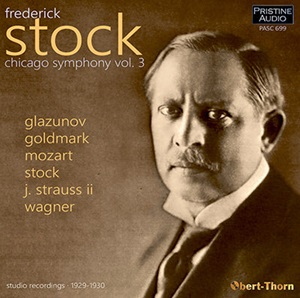
Frederick Stock (conductor)
Chicago Symphony, Volume 3
Alexander Glazunov (1865-1936)
Les ruses d’amour, Op 61: I. Introduction et Scene I II. Ballabile des paysans et des paysannes (1898)
Wolfgang Amadeus Mozart (1756-1791)
Symphony No 40 in G minor, K.550 (1788)
Johann Strauss II (1825-1899)
Emperor Waltz (Kaiser-Walzer), Op 437 (1889)
Richard Wagner (1813-1883)
Tannhäuser – Fest March (1845)
Lohengrin – Prelude to Act 3 (1845-48)
Karl Goldmark (1830-1915)
The Queen of Sheba – Ballet Music (1866-72)
Frederick Stock (1872-1942)
Symphonic Waltz, Op 8 (1907)
rec. 1929-30, Orchestra Hall, Chicago
Pristine Audio PASC699 [67]
Nearly 30 years ago Mark Obert-Thorn transferred a series of Frederick Stock’s recordings for Biddulph (WHL021-22). His current restorations for Pristine Audio have now reached Volume 3 and continue to provide plenty of evidence that Stock was an exceptionally able conductor whose Chicago orchestra was up to all demands made on it.
The focus here is the series of 1929-30 recordings. Three items haven’t been available since their release on 78s; Glazunov’s Ballabile from Les ruses d’amour – its Introduction was included in the Biddulph release, as it is here – Strauss’ Emperor Waltz and Wagner’s Lohengrin Prelude to Act 3. Additionally – and this is really only of interest to shellac nuts, so best move on if you’re not – Biddulph used the first takes of Stock’s own breezy Symphonic Waltz whereas Pristine Audio uses the second takes.
Stock was an especially vibrant conductor of the two Gs – Glazunov and Goldmark. The German-born conductor finds just the right sense of fantasy and colour in the music and in Glazunov he invites shapely, characterful wind solos, crisply performed and rhythmically vivid. It really does make one wish that he’d lived at a time when recording some of the symphonies was a possibility, as he’d have been a perfect fit. Similarly, in Goldmark where he performs the ballet music from The Queen of Sheba, recorded on two 78 sides, with exotic grace and phrasing to match. There’s a touch of unobtrusive surface noise in the Emperor Waltz, but Stock brings a real sense of vitality and good frequency response – Victor’s engineers were on good technical form – and it’s clear that the Strausses, Johann and Richard, were major influences on Stock’s own Symphonic Waltz. The two Wagner works were not coupled together on 78, but are suitably rousing.
The one major work in this volume is Mozart’s G minor Symphony, one of only two works by the composer that Stock recorded – the other was the Prague Symphony. As Obert-Thorn says in his brief producer’s note, Stock’s approach is ‘relatively straightforward’ and indeed it is. There are a few expected slides, but it’s largely unidiosyncratic. In fact, it has a natural nobility of expression, a dignity, that distinguishes it. If the Andante is not expressively overwhelming, it’s of a piece with his conducting as a whole in the symphony – judicious and well-balanced, with a rugged and gutsy Menuetto and a fleetly articulated finale.
The transfers of the Victors have been excellently realized. It’s also good to get a chronologically faithful sequence of recordings – everything except the Glazunov was recorded on 22-23 December 1930 – which adds (to me at least) to the historical frisson of the undertaking.
Jonathan Woolf
Availability: Pristine Classical

















